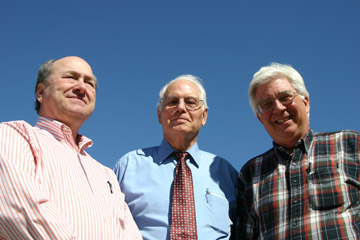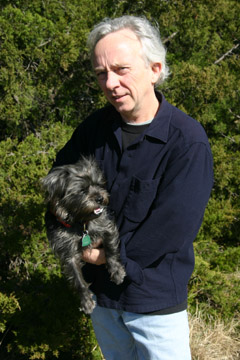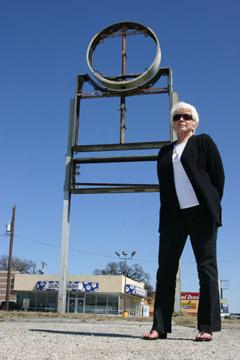|
|
 Crews, left, and Fletcher, rig
Crews, left, and Fletcher, rig
|
 Young: “We were the first orga
Young: “We were the first orga
|
 Deteriorated signs like this o
Deteriorated signs like this o
|
 McBee: “I’ve never been funded
McBee: “I’ve never been funded
|
|
A D V E R T I S E M E N T
|
|
|
|
A D V E R T I S E M E N T
|
|
The East Side Comes Out Swingin’
This group of activists fights city hall on everyone’s behalf.
By JEFF PRINCE
Towering trees are among the many things that attracted Wanda Conlin to the Meadowbrook neighborhood in East Fort Worth five decades ago. She adores them, particularly those on Oakland Boulevard, a popular north-south route where years ago a developer lined both sides of the street with saplings that turned majestic with time.
“When the leaves are on the trees it just frames everything, and it’s so pretty,” she said, anticipating how spring will transform the sparse branches into a green canopy over the street, creating a natural car tunnel.
She drives less than a mile north across the I-30 bridge, and her bubble bursts. Looming near the intersection of Oakland and First Street is a recent industrial site plopped down near two parks and a residential community (and a landfill). Chesapeake Energy has set up shop on a large piece of land formerly known as Arc Park, where teams competed on six softball fields for 25 years. Where the boys and girls of summer once played, there now are drilling rigs, machinery, stacks of pipes, heavy equipment, a constant coming-and-going of truck traffic, and the city’s only injection well, where drillers dump tainted backwash into the earth.
“They’ve got compressor stations, all kinds of stuff,” Conlin said with disgust. By her estimation, Chesapeake’s activity clearly violates zoning requirements, but city officials don’t agree.
Anyone who thinks a little bureaucratic stumbling block can stop Conlin is underestimating this 78-year-old sparkplug, who owns her own community newspaper, volunteers tirelessly, and has earned respect from her neighbors. In a way, she’s the Alpha in a pack of underdog activists who, through sheer will and a growing reliance on technical savvy, are managing to change, if ever so slightly, the city’s direction. She and other Eastsiders are making an art of activism, developing into a force that badgers city hall, affects elections, files lawsuits when needed, and is both courted and despised by city leaders, sometimes in the same breath. In addition to the grand dame of resistance, there’s Conlin’s husband, Don Boren, and Norm Bermes, Don Young, Tony Crews, Pete Fletcher, Louis McBee, Peggy Terrell, Jenny Conn, Rita Vinson, Mike Phipps, and others.
Racial diversity is alive and well on the East Side, but you couldn’t tell it by looking at the area’s activists. They are mostly white, over 50, financially stable — and yet feeling the sting of discrimination. Asked why they create a fuss about so many issues, they describe being shortchanged, slighted, duped, and dumped upon by the city at every turn.
They are often outsmarted and beaten — there’s some truth in the old line, “You can’t fight city hall.” Anyone will lose more than they win against a stacked deck. When the city decided to bunch up its homeless shelters on East Lancaster Avenue, for instance, activists such as Conlin complained at city council meetings and were branded as malcontents (or racists) for their trouble.
But they’ve had successes, such as getting the dilapidated Cowtown Inn torn down, squeezing gas drillers for more money, pushing for the city’s first tree-protection ordinance, rezoning two sprawling neighborhoods to clock a land-grabbing developer, and winning approval of a sign ordinance to clean up blight along city streets.
They don’t own a monopoly on hell-raising. Activists sprinkled throughout the city are motivated by similar feelings. You see them in the largely African-American sections of town in the southeast and in the Hispanic neighborhoods on the North Side. Even tony West Side neighborhoods have their dissenters. But nobody bucks the system as loudly and consistently as the East Side, an area spelled out in the city’s comprehensive plan as east of I-35 and roughly bordered by the Trinity River on the north and Lancaster Avenue on the south. Inside those imaginary lines, the activists, advocates, revolutionaries, rabble-rousers — whatever you want to call them — approach resistance like a sweet science, and their cohesion and effectiveness continue to grow.
A persecution complex has permeated the East Side for a long time.
“I’ve been out here 20 years and noticed how we were always, to quote the farmers, sucking the hind teat,” Woodhaven resident Norm Bermes said.
Understanding why Eastsiders feel mistreated requires going back to when Fort Worth was called Cowtown for practical rather than marketing purposes. After the Civil War, beef was fetching top dollar up north, and cattle drives created a boon for the city’s Northside stockyards. Millions of head of cattle, sheep, and pigs took their final steps up a ramp at those slaughterhouses, and the resulting mix of odors — blood, guts, and poop — was staggering. Prevailing winds pushed them eastward. Residents looking to settle down and buy a home often looked any direction but east. The richest among them went in the opposite direction even though the city’s West Side was mostly flat and tree-challenged.
The odor from the Stockyards wasn’t the only thing moving in an easterly direction. The Trinity River flows that way as well. In the city’s early days, an informal trash dump was established near the riverbank on the east side of town — it wasn’t an environmentally sound location, but at least if anything harmful got into the water it flowed away from Fort Worth (and toward Dallas, which seemed fitting to some locals). The city’s first sewage treatment plant was established east of town for the same reason. East became synonymous with a dumping ground — ironic since, topographically, no other part of the city can compete with the beauty of the East Side’s rolling hills, trees, and vistas.
Morris Matson was living in southwest Fort Worth when he started working as an assistant city manager in 1971. He quickly discovered that the most impassioned activists hailed from the east, and they began bending his ear almost immediately.
“When I first went to work for the city, I asked the same question — why does the East Side have such an attitude?” he said.
Back then, co-workers in the city manager’s office explained how the persecution complex started decades earlier, when the East Side was downstream, downwind, disregarded, and under-represented at city hall. Even millionaire newspaper publisher Amon Carter, who made a career of bragging on Fort Worth, was cold toward the East Side, Matson was told. In Carter’s vernacular, “east” was seldom used as anything but a criticism.
“The power in Fort Worth was all on the West Side,” Matson said. “When you got past downtown Fort Worth [heading east], it didn’t matter.”
From 1957 to 1977, the Dallas-Fort Worth Turnpike, later to become I-30, drew motorists away from East Lancaster Avenue, which at the time was part of U.S. 80 and a thriving boulevard of restaurants, department stores, motels, and mom-and-pop businesses. Many of those businesses died off, and the resulting blight still exists there today. A glut of factories, foundries, and warehouses clustered along East 4th and East 5th, and other streets east of downtown, along with a maze of railroad tracks. The wastewater treatment plant built in Riverside closed in 1980, replaced by the larger Village Creek Wastewater Plant, also on the East Side.
“They moved the odor problem further east,” Matson said.
After moving to Woodhaven in 1977, Matson got to know many Eastsiders and was struck by their tenacity as well as by their ingrained feelings of being from “the wrong side of the tracks,” he said.
“The people knew they had to keep organized to get anything from Fort Worth, and that practice continues today,” he said. “They feel like they’re looked down upon.”
Still, organization has been slow to come. For years, activists concerned themselves with issues in their own backyard. And even today, activists from different neighborhoods don’t necessarily socialize all that much; one street’s problems don’t always interest folks from around the block, and some activists just don’t like each other (many can be intense, Type-A, and, let’s be honest, annoying at times).
More recently, however, they’ve taken the age-old concept of strength in numbers to a new level.
Norm Bermes is a gentle guy with a ready smile who leads volunteers on various do-gooder missions in his Woodhaven neighborhood, from cleaning up litter along riverbanks to providing computers to poor children in nearby apartments. His white hair frames piercing eyes, and he carries himself with a sense of calm and reason that’s often missing from folks who get riled up about real or imagined injustices. So he’s a bit of a Pied Piper, attracting others with his restrained and gentlemanly rebellion.
A handful of them get together weekly at local restaurants to hash out the latest news and gossip. Luby’s on Bridge Street is a favorite spot, but the group spreads the love among a number of eateries, which pleases restaurateurs — well, most of the time. Folks who are willing to stand in front of the city council to voice a suggestion or complaint while Mayor Mike Moncrief peers down at them over the top of his spectacles also don’t think twice about informing a cafeteria manager when a baked potato is overdone or the service is underwhelming.
Woodhaven residents Pete Fletcher and Tony Crews are regulars at these luncheons; Bermes inspired both to get involved in neighborhood issues.
“To me, he’s a positive influence and not a rabble-rouser at all,” Crews said.
Perhaps, but city officials and politicians don’t often enjoy people showing up to point out problems with the latest, greatest plan being charged to the taxpayers’ bill. Some treat residents like irritants rather than constituents, Crews said. Activists spend hours of time and energy — and their own money — working within the democratic system to fight for what they feel is right, yet to many city officials “you’re just a nut,” Crews said.
Fletcher, another gray-haired guy willing to tangle when his sense of fairness is upset, put it as simply as possible.
“I don’t like wrongs, and this makes me an activist,” he said.
Fletcher and Crews are energetic, talkative, sometimes over the top, and certainly more excitable than Bermes. Not everyone mirrors the calmness under fire displayed by Bermes and Conlin, but each has his or her own style. This Eastside lineage includes U.S. Rep. Kay Granger, the highest ranking Republican woman in the House of Representatives, whose political career traces back to the 1980s, when she lived near Woodhaven. Upset by an industrial plant seeking a city permit to operate near her home, she rebelled, was appointed to the city’s zoning commission, became a city council member in 1989, and eventually served as mayor for five years before heading to Washington, D.C.
Granger’s aide back in the 1980s was another particularly persuasive person, Becky Haskin. The pretty blonde woman was a force of nature, seemingly everywhere, fiercely protective of her neighborhood, and adept at swinging popular opinion her way. She was elected to the city council in 1992 and served six terms.
At first, Conlin and Haskin were a mutual admiration society. Haskin appointed Conlin to the Planning Commission, then nine years later to the Zoning Commission, both influential positions for controlling development on one’s home turf. They mostly agreed on quality-of-life issues such as billboard restrictions, landscape ordinances, and code compliance.
After several years in office, however, Haskin began treating activists like a nuisance. She coined the phrase “CAVE” people — “citizens against virtually everything” — to describe them or anyone else who disagreed with her often- polarizing plans to shut down apartments, run poor people out of her neighborhood, and block the construction of a recreation center for fear it would attract black kids to basketball courts. Her elitist attitude ran her afoul of Conlin, Bermes, and others, and it’s no coincidence that her political career crashed and burned not long afterward.
The final break between Haskin and Conlin occurred in 2004, when the city was seeking support for a $273 million bond package. To Haskin’s dismay, Conlin not only withdrew her support, she sent out a strongly worded e-mail declaring she would vote against the bond package because the city’s priorities were skewed and the East Side was again being shortchanged. An irreverent stone had been cast. Didn’t matter, though — the bond package passed.
Haskin retaliated by yanking Conlin from the Zoning Commission. But she hadn’t counted on Conlin’s popularity. The veteran activist’s rational approach and years of public service had earned her plenty of friends, and many of them turned on Haskin. In 2006, the former political wunderkind and Granger protégé couldn’t even win a justice of the peace election against political neophyte Ralph Swearingen. She has hardly been seen or heard from since.
At Conlin’s side throughout the 2004 bond election uprising was Louis McBee, whose attempt that same year to replace Haskin on the city council was proof the incumbent’s support was crumbling. McBee, a small-time businessman and political unknown, almost beat the longtime incumbent. He was well known and almost roundly disliked by the Fort Worth City Council for his assortment of protests, such as trying to prevent funding for the Fort Worth Crime Control and Prevention District after questioning the manner in which the police department was spending the money. But he really created a stir when he accused Moncrief and a couple of city council members of acting unethically before granting $30 million in tax breaks to the outdoor store Cabela’s.
McBee blasted the corporate giveaway as “welfare for the rich” and, as a member of Citizens for Responsible Government, demanded a ruling from state court as to whether the deal was legal. A county district court ruled in favor of the city and upheld the city’s request that the group post a $300,000 bond before appealing the ruling. The dispute fizzled, and Cabela’s got its money.
“We didn’t have $300,000 to post a bond,” McBee said.
He later ran against Danny Scarth to fill Haskin’s vacated city council seat in 2006 and again lost in a close election. McBee had almost no financial support, while Scarth’s campaign was financed by the oil and gas industry and the downtown elite and propped up by endorsements from Granger, Moncrief, and others who quaked at the thought of the independent and outspoken McBee holding a position of power.
“I’ve never been funded by the Fort Worth big money and probably never will be, and the elections in Fort Worth are about money,” he said. “It’s amazing — he [Scarth] had all the money and endorsements in the campaign, and he could only win by 54 votes. If they had left that election alone, I would be councilman today.”
And then along came the biggest business phenomenon and neighborhood impact of the new millennium — natural gas drilling in urban areas. The East Side, with its open land, floodplains, and industrial sites, drew drillers like a magnet. Woodhaven was one of the first neighborhoods to sign over its mineral rights and, as a result, agreed to much smaller bonuses and royalties than many neighborhoods are demanding and getting nowadays. Likewise, the city’s first permit for an injection well for gas drillers was granted at the former Arc Park. The proliferation spurred more organization, and, earlier this year, five neighborhood associations that had previously not paid much attention to one another joined forces. They formed the Greater Meadowbrook Mineral Leasing Task Force, representing owners of about 5,400 residential lots, and then notified Barnett Shale drillers that the industry standard — about $5,000 to $10,000 bonus payment per acre and 25 percent royalties — was no longer acceptable. They demanded $30,000 per acre and 30 percent royalties.
After weeks of negotiations with gas companies, the task force is on the verge of sealing a historic deal this week.
“We have a deal pending for $25,000 an acre and 26.5 percent,” McBee said. “It’s going to be a record-setting deal. Nobody’s gotten that much. In addition, should this deal go through, there will be no drilling in Meadowbrook at all.”
Don Young, yet another gray-haired white dude on a mission, surfaced several years ago when the proliferation of urban gas wells hit close to his home. Tandy Hills Park, a nature preserve close to Beach Street and I-30, is near and dear to his heart and his house. He was alarmed when the city began talking about drilling underneath the park in 2004. Young had never been a “naysayer,” the word city types use to describe anyone who questions their decisions. But Young decided a line had been crossed, and he began an odyssey of protest that led to the creation of Fort Worth Citizens Against Neighborhood Drilling Ordinance (FWCanDo).
“We started out as our neighborhood in West Meadowbrook, interested in protecting out own backyard,” he said. “Then we went citywide, then statewide, and now we’re national to some extent. We were the first organized group to fight gas drilling in Texas.”
Young’s willingness to use multiple media to spread his message has helped his protest. He’s printed about 2,000 “Just Say No To Urban Gas Drilling” placards; they’re now in front yards across the city. In 2005 he recruited college film students to make “Dirty Ol’ Town,” a video designed to counteract the city’s Pollyanna presentation of drilling. He’s had at least 200 duplicates made and mailed to other protest groups. The project was given additional credibility by the inclusion of Tarrant County Commissioner J.D. Johnson, who described woes with drillers near his home north of Fort Worth.
“I get requests for that video from all over the country,” Young said.
In 2006, he hosted the first Fort Worth Prairie Fest to expose residents to Tandy Hills’ beauty and to warn them of the threat from gas drillers. He’s now preparing for the third annual event, and attendance has grown each year.
In December 2007, he solicited local artists to create works inspired by urban gas drilling. The resulting exhibit, Buzzworms in the Backyard, at the Fort Worth Community Arts Center, drew about two dozen entries.
“I gave away out of my own pocket a thousand dollars in prize money to the top three winners,” he said. “Opening night we had at least 100 people crammed in a room to look at the art. I’m planning to do it again next year.”
Then, there’s Young’s steady stream of e-mails sent to people citywide, including to the various city officials he often butts heads with. Moncrief in particular is a frequent target of Young’s cyber-grenades.
And Young is considering new ways to spread his message.
“We haven’t published a book yet,” he said.
Technology helps get the word out on activists’ causes these days, but it doesn’t guarantee a response, he said. Passion and persistence are still the keys to bringing about change.
“It’s going to take a lot more than technology, it’s going to take people to wake up,” he said. “Technology is just another hammer to hit them over the head with.”
Taking a stand against the city’s drilling policies, not to mention bucking neighbors who are quite willing to overlook environmental and safety concerns in exchange for a royalty check, isn’t exactly a sound business plan for a small entrepreneur. Some see Young as heroic. Others see him as a royal pain in the ass or, worse, a nut job. He has owned an art glass business for years, and at first he worried his activism would hurt sales. It hasn’t. He is just as likely to earn new clients who appreciate his community efforts.
Along the way, Young’s personal style of protest has evolved. He’s a mild wallflower by nature, so it caught some people by surprise, including Young himself, when he attended the city’s first gas drilling task force meeting a few years ago and found himself yelling from the peanut gallery, angry that the group was stacked with oil and gas representatives. His outbursts frazzled and angered the committee members, and the chairperson threatened to evict the spectators. His temper still flares once in a while, but not often.
“I’ve moderated,” he said. “I have friends who tell me when I need to tone it down. I realized there were other ways to get my message across without disrupting meetings. I learned the rules as I went along. I’d never done anything like this before.”
He’s also learned about the downside of activism. While he hasn’t been assaulted, he reported being intimidated and threatened by oil and gas landmen at a protest a couple of years ago.
“I started looking behind me more often after that,” he said. “My wife was scared and I was scared too, to tell you the truth. Those guys are beefy, and they don’t have a lot of brains.”
Young is a slight, wiry guy who probably wouldn’t last long in a fistfight with a roughneck. But, like other Eastside activists, he focuses on his passion and tends to ignore the personal costs.
“I have firm convictions,” he said. “My wife has begged me to stop because it’s so stressful and it costs a lot of money and eats up so much of my time. But I’m not going to stop.”
Alliances are changing the dynamics of activism and could likewise alter the political landscape. Controversial issues such as public spending on the Trinity Uptown project could face more obstacles than ever with a more unified voting bloc.
Recently, the East Side Sector Alliance, made up of about a dozen neighborhoods — and an estimated 1,000 votes on election day — sent a letter to the city council saying they won’t support the 2008 bond proposal if the $10.2 million for bridges related to the Trinity River Uptown project isn’t removed.
“We’re going to actively oppose it, print yard signs and everything,” McBee said.
And, they are thinking citywide rather than focusing solely on their own backyards — just like the East Side did when its leaders drove the efforts against Cabela’s, located miles away on the city’s North Side.
“Our interest is global,” Conlin said. “We drove down Rosedale Avenue [in the Southeast], and it looked like a war zone, with trashy signs everywhere, and we drove down Lancaster Avenue and it looked nearly as bad, so we just started raising hell until we finally put together a sign committee.”
The committee won city approval of a revised and toughened ordinance, but the group hasn’t exactly declared victory. Ugly signs remain.
“We haven’t gotten rid of all the signs yet because the city isn’t enforcing it like they need to,” she said.
And so they’ll keep stomping through the corridors of city hall and developing new methods of uniting and organizing that provide more clout. That’s a nice thought for the activists and surely a scary one to the people in town who are used to pulling the strings.
“The benefit to the future will be huge,” McBee said. “Now we all know each other, and we have the ability to reach out overnight with e-mails. We have a unity we’ve never had before.”
You can reach Jeff Prince at jeff.prince@fwweekly.com.
 Email this Article...
Email this Article...

